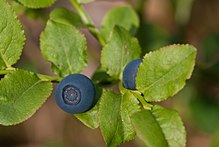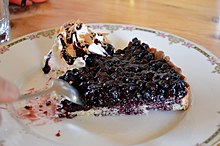A | B | C | D | E | F | G | H | CH | I | J | K | L | M | N | O | P | Q | R | S | T | U | V | W | X | Y | Z | 0 | 1 | 2 | 3 | 4 | 5 | 6 | 7 | 8 | 9

Bilberries (/ˈbɪlbəri/) or blueberries are Eurasian low-growing shrubs in the genus Vaccinium in the flowering plant family Ericaceae that bear edible, dark blue berries. The species most often referred to is Vaccinium myrtillus L., but there are several other closely related species.
Etymology and common names
The name "bilberry" appears to have a Scandinavian origin, possibly from as early as 1577, being similar to the Danish word bølle for whortleberry with the addition of "berry".[1] In Scandinavian languages, terms for bilberries have names that carry the meaning "blueberry": e.g. blåbär in Swedish and blåbær in Danish and Norwegian.[citation needed]
The bilberry (especially Vaccinium myrtillus) is generally known as blaeberry /ˈbleɪbɛri/ in Scottish and Northern English regional dialects,[2] and whortleberry /ˈhwɜːrtəbri/ in southern England.[2]
Description and species
This section needs additional citations for verification. (January 2021) |


Bilberries —which are native to Europe— are different from North American blueberries, although the species are closely related and belong to the same genus, Vaccinium. Bilberry are non-climacteric fruits with a smooth, circular outline at the end opposite the stalk, whereas blueberries retain persistent sepals there, leaving a rough, star-shaped pattern of five flaps.[3] Bilberries grow singly or in pairs rather than in clusters, as blueberries do, and blueberries have more evergreen leaves. Bilberries are dark in colour, and often appear near black with a slight shade of purple.
Bilberries and blueberries contain diverse anthocyanins, specifically anthocyanidins, including delphinidin and cyanidin glycosides.[4][5] While blueberry fruit pulp is light green, bilberry is red or purple. The high anthocyanin content may cause staining of the fingers, lips, and tongue.[4]
Bilberries include several closely related species of the genus Vaccinium, including:
- Vaccinium myrtillus L. (bilberry)
- Vaccinium uliginosum L. (bog bilberry, bog blueberry, bog whortleberry, bog huckleberry, northern bilberry, ground hurts)
- Vaccinium cespitosum Michx. (dwarf bilberry)
- Vaccinium deliciosum Piper (Cascade bilberry)
- Vaccinium membranaceum (mountain bilberry, black mountain huckleberry, black huckleberry, twin-leaved huckleberry)
- Vaccinium ovalifolium (oval-leafed blueberry, oval-leaved bilberry, mountain blueberry, high-bush blueberry).
These species, with the exception of V. uliginosum, are part of section Myrtillus.[6]
Wild and cultivated harvesting
This section needs additional citations for verification. (January 2021) |

Bilberries are found in acidic, nutrient-poor soils throughout the temperate and subarctic regions of the world. They are difficult to grow and the fruit is small, so they are seldom cultivated. Fruits are mostly collected from wild plants growing on publicly accessible lands throughout northern and central Europe where they are plentiful – for example, up to a fifth (17–21%) of the land area of Sweden contains bilberry bushes, where it is called blåbär (lit. "blueberry", which is a source of confusion with the American blueberry).[7] Bilberries can be picked by a berry-picking rake like lingonberries, but are more susceptible to damage. They are softer and juicier than blueberries, making them difficult to transport. Because of these factors, fresh bilberries are only available from markets and gourmet stores. Frozen bilberries, however, are available year round in many parts of Europe.
In Iceland, bilberries (known as aðalbláber, or "prime blueberry") grow predominantly in Westfjords and the surrounding area. In most of the country, the closely related bláber occupy the same habitat. Both species are commonly found growing with dwarf birch and crowberries. Wild growth is vast compared to the population of Iceland and wild harvesting is legal, and a popular activity in August when the berry season peaks.
In Ireland, the fruit is known as fraughan, from the Irish fraochán, and is traditionally gathered on the last Sunday in July, known as "Fraughan Sunday". Bilberries were also collected at the Celtic festival of Lughnasadh in August, the first traditional harvest festival of the year. The crop of bilberries was said to indicate how well the rest of the crops would fare in their harvests later in the year.
Bilberry is used as a food plant by the larvae of some Lepidoptera species (see the list of Lepidoptera that feed on Vaccinium).
Food

The fruits are eaten fresh or made into jams, fools, juices, or pies. In France and Italy, they are used as a base for liqueurs and are a popular flavouring for sorbets and other desserts. In Brittany, they are often used as a flavouring for crêpes. In the Vosges and the Massif Central, bilberry tart (tarte aux myrtilles) is a traditional dessert. In Romania, they are used as a base for a liqueur called afinată – the name of the fruit in Romanian is afină. In Nordic countries, they are eaten fresh or made into jams and other dishes, including bilberry pie (Finnish mustikkapiirakka, Swedish blåbärspaj) and blåbärssoppa, a bilberry soup served hot or cold. In Iceland they are popularly eaten with skyr (a cultured dairy product similar to yoghurt). In Poland, they are eaten fresh (often mixed with sugar), as a filling in a sweet yeast-leavened bun known as jagodzianka, in jams (known for their health benefits in the treatment of diarrhoea) and with śmietana (a soured cream) or unsoured cream as a sauce for rice or pasta for a light summertime meal.[citation needed]
Research
One review of low-quality clinical research concluded there was no evidence that consuming bilberries improves night vision.[8] Bilberries have been used in a variety of folklore and traditional medicine, but there are no proven health benefits or anti-disease effects from consuming them.[9]
Diseases
Bilberry plants can suffer from bilberry blight,[10] caused by Phytophthora kernoviae. There have been severe outbreaks in Staffordshire, England.[11]
References
- ^ "Bilberry". Merriam-Webster Dictionary. Merriam-Webster, Incorporated. 2016. Retrieved 1 January 2017.
- ^ a b Blamey, M.; Fitter, R.; Fitter, A (2003). Wildflowers of Britain and Ireland: The Complete Guide to the British and Irish Flora. London: A & C Black. p. 106. ISBN 978-1-4081-7950-5.
- ^ Voss, E.G. (1996). Michigan Flora Part III Dicots Concluded. Cranbrook Institute of Science. p. 46. ISBN 1-877370-40-1.
- ^ a b Burdulis, D.; Ivanauskas, L.; Dirse, V.; Kazlauskas, S.; Razukas, A. (2007). "Study of diversity of anthocyanin composition in bilberry (Vaccinium myrtillus L.) fruits" (PDF). Medicina (Kaunas). 43 (12): 971–7. doi:10.3390/medicina43120127. PMID 18182842.
- ^ Lätti, A.K.; Riihinen, K.R.; Kainulainen, P.S. (2008). "Analysis of anthocyanin variation in wild populations of bilberry (Vaccinium myrtillus L.) in Finland". Journal of Agricultural and Food Chemistry. 56 (1): 190–6. doi:10.1021/jf072857m. PMID 18072741.
- ^ Kathleen A. Kron; E. Ann Powell; J. L. Luteyn (2002). "Phylogenetic relationships within the blueberry tribe (Vaccinieae, Ericaceae) based on sequence data from MATK and nuclear ribosomal ITS regions, with comments on the placement of Satyria". American Journal of Botany. 89 (2): 327–336. doi:10.3732/ajb.89.2.327. PMID 21669741.
- ^ sv:Blåbär
- ^ Canter, Peter H; Ernst, Edzard (2004). "Anthocyanosides of Vaccinium myrtillus (Bilberry) for Night Vision—A Systematic Review of Placebo-Controlled Trials". Survey of Ophthalmology. 49 (1): 38–50. doi:10.1016/j.survophthal.2003.10.006. ISSN 0039-6257. PMID 14711439.
- ^ "Bilberry". National Center for Complementary and Integrative Health, US National Institutes of Health. September 2016. Retrieved 26 January 2018.
- ^ "Phytophthora". Natural England. Archived from the original on 27 March 2012. Retrieved 26 June 2011.
- ^ "Disease of Bilberry (Phytophthora)". Staffordshire County Council. Archived from the original on 27 January 2018. Retrieved 26 January 2018.
>Text je dostupný pod licencí Creative Commons Uveďte autora – Zachovejte licenci, případně za dalších podmínek. Podrobnosti naleznete na stránce Podmínky užití.
Bilberry (disambiguation)
File:Vaccinium myrtillus Mustikka IMG 1100 C- cropped.jpg
Help:IPA/English
Eurasia
Shrub
Vaccinium
Flowering plant
Ericaceae
Vaccinium myrtillus
Scandinavian languages
Whortleberry
Wikipedia:Citation needed
Help:IPA/English
Help:IPA/English
File:Question book-new.svg
Wikipedia:Verifiability
Special:EditPage/Bilberry
Help:Referencing for beginners
Help:Maintenance template removal
File:Lahemaa mustikad.jpg
File:Fresh bilberries picked in Tuntorp 4.jpg
Blueberry
Vaccinium
Climacteric (botany)
Sepal
Anthocyanin
Anthocyanidin
Delphinidin
Cyanidin
Glycoside
Vaccinium myrtillus
Vaccinium uliginosum
Vaccinium cespitosum
Vaccinium deliciosum
Vaccinium membranaceum
Vaccinium ovalifolium
Section (botany)
File:Question book-new.svg
Wikipedia:Verifiability
Special:EditPage/Bilberry
Help:Referencing for beginners
Help:Maintenance template removal
File:Norwegian blueberries.jpg
Acid
Soil
Temperate
Subarctic
Sweden
Berry-picking rake
Lingonberry
Westfjords
Vaccinium uliginosum
Betula nana
Empetrum nigrum
Irish language
Lughnasadh
Larva
Lepidoptera
File:Tarte aux myrtilles, Refuge du Lac du Lou, Les Belleville.jpg
Jam
Fruit fool
Juice
Pie
Liqueur
Sorbet
Brittany
Crêpe
Blåbärssoppa
Skyr
Diarrhoea
Smetana (dairy product)
Wikipedia:Citation needed
Clinical research
Night vision
Folklore
Traditional medicine
Phytophthora kernoviae
Staffordshire
ISBN (identifier)
Special:BookSources/978-1-4081-7950-5
ISBN (identifier)
Special:BookSources/1-877370-40-1
Doi (identifier)
PMID (identifier)
Doi (identifier)
PMID (identifier)
Doi (identifier)
PMID (identifier)
Blåbär
Doi (identifier)
ISSN (identifier)
PMID (identifier)
Natural England
Staffordshire County Council
Special:Search/bilberry
Vaccinium myrtillus
Wikisource
Encyclopædia Britannica Eleventh Edition
1911 Encyclopædia Britannica/Bilberry
Template:Blueberries
Template talk:Blueberries
Special:EditPage/Template:Blueberries
Blueberry
Vaccinium angustifolium
Vaccinium boreale
Vaccinium caesariense
Vaccinium corymbosum
Vaccinium darrowii
Vaccinium elliottii
Vaccinium fuscatum
Vaccinium hirsutum
Vaccinium koreanum
Vaccinium meridionale
Vaccinium myrsinites
Vaccinium myrtilloides
Vaccinium pallidum
Vaccinium tenellum
Vaccinium virgatum
File:Antioxidant-berries-bilberry-988870.jpg
Blåbärssoppa
Blueberry pie
Blueberry sauce
Blueberry tea
Category:Blueberries
Template:Non-timber forest products
Template talk:Non-timber forest products
Special:EditPage/Template:Non-timber forest products
Non-timber forest product
Animal product
Fur
Honey
Pine honey
Game (hunting)
Berry
Fruit tree
Banana
Garcinia binucao
Blackberry
Blueberry
Breadfruit
Cocoa bean
Coconut
Durian
Garcinia gummi-gutta
Huckleberry
Jackfruit
Juniper berry
Vaccinium vitis-idaea
Raspberry
Strawberry
Tamarind
Fragaria vesca
List of leaf vegetables
Root
Betel
Fiddlehead
Heart of palm
Madhuca longifolia#Mahuwa flowers
Metroxylon sagu
Cycas circinalis
Sassafras
Filé powder
Root beer
Serenoa
Ginseng#Wild ginseng
Wild onion
Allium ursinum
Allium canadense
Allium vineale
Allium bisceptrum
Allium validum
Allium tricoccum
Edible mushroom
Russula vesca
Imleria badia
Leccinum scabrum
Boletus edulis
Cantharellus
Armillaria mellea
Lingzhi (mushroom)
Matsutake
Agaricus campestris
Morchella
Pleurotus ostreatus
Macrolepiota procera
Leccinum aurantiacum
Lactarius deliciosus
Suillus luteus
Truffle
Tricholoma equestre
Nut (fruit)
Spice
Allspice
Areca nut
Bay leaf
Black pepper
Brazil nut
Cinnamon
Clove
Hazelnut
Scaphium affine
Nutmeg
Pine nut
Vanilla
Vegetable oil
Wax
Allanblackia oil
Babassu oil
Platonia
Candlenut oil
Theobroma grandiflorum
Carnauba wax
Hydnocarpus wightiana seed oil
Cocoa butter
Eucalyptol
Eucalyptus oil
Illipe
Japan wax
Kokum oil
Pycnanthus angolensis
Pentadesma butyracea
Kusum oil
Trichilia emetica
Madhuca longifolia#Oil
Mango oil
Astrocaryum murumuru
Nagkesar seed oil
Palm oil
Palm kernel oil
Phulwara oil
Pilu oil
Pongamia oil
Shorea robusta seed oil
Sandalwood oil
Shea butter
Tamanu oil
Tea seed oil
Tea tree oil
Astrocaryum aculeatum
Ucuhuba seed oil
Vateria indica oil
Resin
Benzoin (resin)
Birch tar
Camphor
Creosote#Wood-tar creosote
Frankincense
Gamboge
Kauri gum
Lacquer
Mastic (plant resin)
Myrrh
Pine tar
Pitch (resin)
Rosin
Turpentine
Varnish
Sap
Natural gum
Birch syrup
Chicle
Chewing gum
Coconut sugar
Date sugar
Fruit syrup
Gum arabic
Gutta-percha
Kino (botany)
Latex
Maple sugar
Maple syrup
Palm sugar
Palm wine
Akpeteshie
Ogogoro
Natural rubber
Spruce gum
Amadou
Bamboo
Bamboo shoot
Bamboo musical instruments
Bamboo textile
Birch bark
Birch beer
Cork (material)
Fern
Forage
Uncaria
Moss#Commercial
Natural dye
Henna
Peat
Quinine
Rattan
Shellac
Tanbark
Tannin
Diospyros melanoxylon
Thatching
Vegetable ivory
Willow#Medicinal
Dehesa
Forest farming
Forest gardening
Honey hunting
Forest produce (India)
Mushroom hunting
Naval stores
Resin extraction
Rubber tapping
Wildcrafting
Category:Non-timber forest products
Category:Non-timber forest products
Help:Authority control
Q60708120#identifiers
Bilberry
Bilberry
Main Page
Updating...x
Text je dostupný za podmienok Creative
Commons Attribution/Share-Alike License 3.0 Unported; prípadne za ďalších
podmienok.
Podrobnejšie informácie nájdete na stránke Podmienky
použitia.


